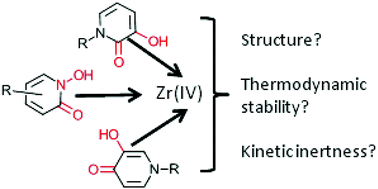Investigation of the complexation of natZr(iv) and 89Zr(iv) by hydroxypyridinones for the development of chelators for PET imaging applications†
Abstract
Three hydroxypyridinone (HOPO) positional isomers – 1,2-HOPO (L1H) and its water soluble analogue (L1′H), 3,2-HOPO (L2H) and 3,4-HOPO (L3H) have been investigated for the complexation of Zr(IV). Potentiometric and UV-Vis spectrometric studies show a higher thermodynamic stability for the formation of Zr(L1′)4 in comparison with Zr(L2)4 and Zr(L3)4 as well as a higher kinetic inertness in competition studies with EDTA or Fe3+ at a radiotracer concentration with 89Zr. Besides the low pKa of L1H or L1′H (pKa = 5.01) in comparison with L2H and L3H (pKa = 8.83 and 9.55, respectively), the higher stability of Zr(L1′)4 can be attributed in part to the presence of the amide group next to the chelating oxygen that induces intramolecular H-bond and amide/π interactions that were observed by X-ray crystallography and confirmed by quantum chemical calculations. The data presented here indicate that the 1,2-HOPO L1′ exhibits the best characteristics for Zr(IV) complexation. However, 3,2-HOPO and 3,4-HOPO patterns, if appropriately tuned, for instance with the addition of an amide group as in the 1,2-HOPO ligand, may also become interesting alternatives for the design of Zr(IV) chelators with improved characteristics for applications in nuclear imaging with 89Zr.



 Please wait while we load your content...
Please wait while we load your content...